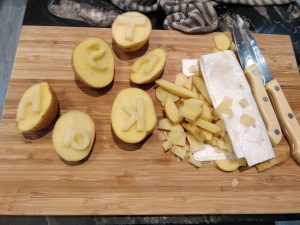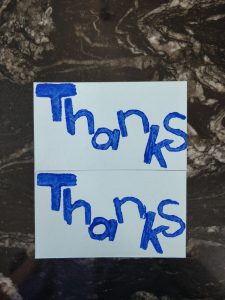General Observations
I found it very interesting that my default approach to this assignment was with a creative lens – similar to cardmaking that I’ve done in the past – rather than an academic one. When deciding which word to produce, chose something that could be reused; I anticipated time investment and artistic quality and wanted to leverage the effort. As a result, I selected the word ‘Thanks.’

Was there something particularly challenging in the process?
I wouldn’t say that anything was particularly challenging about this experience, but there were a few hiccups along the way. Despite Cooke’s (2012) video that showed the stamps backwards and upside-down, I ended up making the first three potato stamps with the letters facing forward. The capital ‘T’ was forgiving but the ‘h’ and the ‘a’ stamps had to be redone. Also, the stamps – and the letters they produced – were not perfect; it took me a bit to get over this.
I also considered aspects like potato selection to font style, tried to have all the stamps match in terms of line thickness, and ultimately accepted that hand-carved stamps had more irregularities than anything produced through machine manufacturing.
How much time did it take for you to create the stamps?
I lose track of time while making the potato stamps; my mind wandered while creating them, which I suspect is similar to what Paul Collier described of his own experiences in Cooke’s (2012) video. I estimate that it took me about 45 minutes to an hour to make all six stamps, but I really wasn’t tracking the time as I found it relaxing and enjoyable to be working on something creative and tangible.
Have you noticed anything particular about the letters that you have chosen to reproduce?
Instead of using new potatoes to resolve my initial mistake of carving the letters the wrong way, I cut off the first attempt and carved the second attempt on the same potato half. This meant that the second attempt still included some deeper cuts from the first attempt and, as a result, some of the letters did not print clearly or printed the ink with texture rather than a solid print. Also, most stamps had a natural curve to them and required a second (or third) stamping attempt to fully stamp the letter as anticipated. Even still, the ‘a’ was missing a chunk, however, since it was still clearly an ‘a’ I used it anyway. I also misjudged the length of the word with the first attempt and found that the way the ‘k’ and ‘s’ landed on the page looked awkward, thus prompting the second stamping attempt.
Considering the time and effort that it took you to create a 5-letter word, how do you feel about the mechanization of writing?
The mechanization of writing has allowed for mass production and incredible flexibility. The amount of text I could have typed in 45 minutes far surpasses what I could have printed with potatoes or even a letterpress. The efficiency of fixing errors and reproducing copies of text using technology far exceeds that of hand writing or printing with stamps. Since text is primarily produced mechanically nowadays, handwritten or hand-stamped items can be seen as more valuable or personal, with increased emotion. For many, a handwritten card is of higher value than a typed email, and a handmade card is often considered more beautiful than a store-bought one. The idea that someone would purposely choose the less-efficient path to create text or a piece of writing brings about a sentimental feeling, akin to homemade cookies versus store-bought ones.


Attempt 1 (left) and attempt 2 (right).
Reference
Cooke, D. (2012, January 26). Upside down, left to right: A letterpress film [Video]. YouTube. https://www.youtube.com/watch?v=n6RqWe1bFpM
